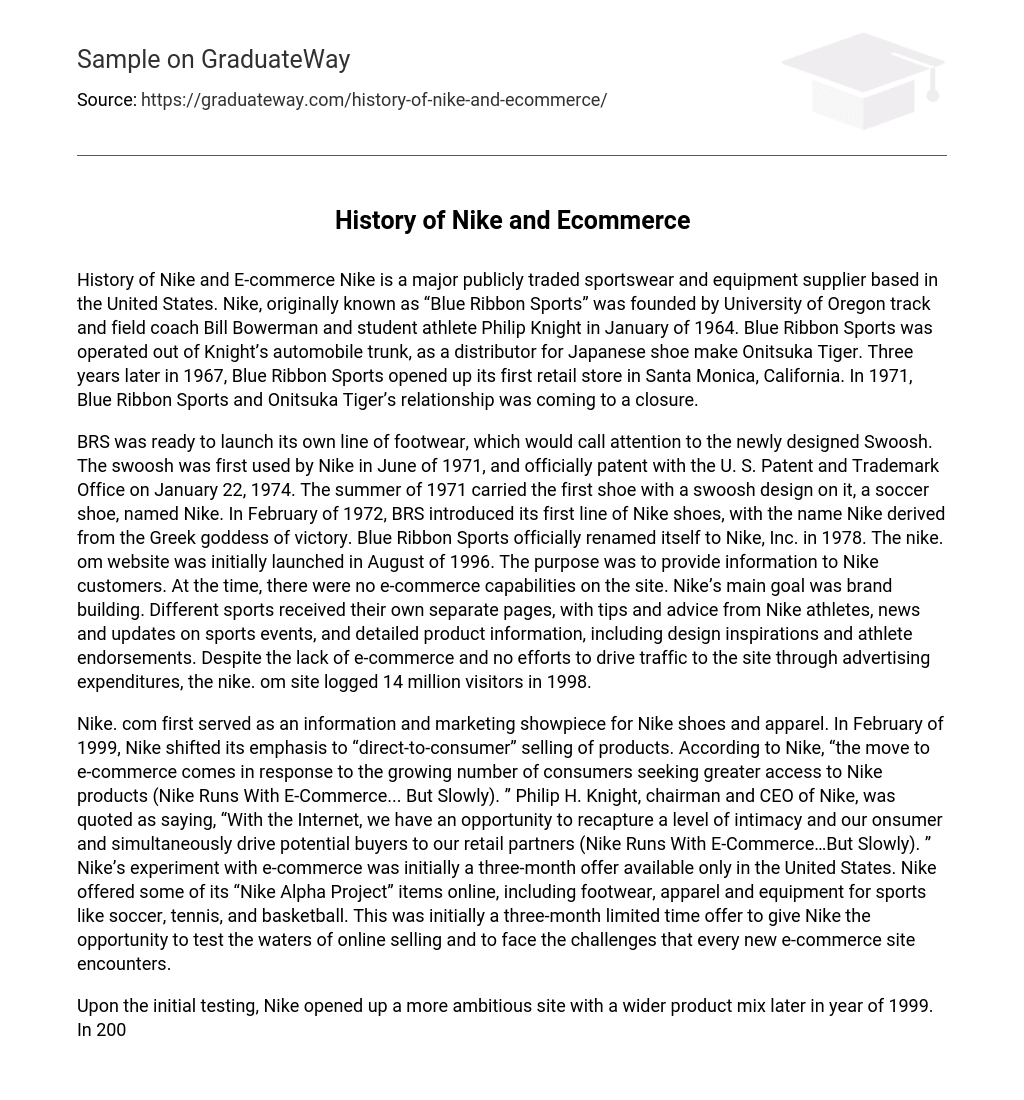History of Nike and E-commerce Nike is a major publicly traded sportswear and equipment supplier based in the United States. Nike, originally known as “Blue Ribbon Sports” was founded by University of Oregon track and field coach Bill Bowerman and student athlete Philip Knight in January of 1964. Blue Ribbon Sports was operated out of Knight’s automobile trunk, as a distributor for Japanese shoe make Onitsuka Tiger. Three years later in 1967, Blue Ribbon Sports opened up its first retail store in Santa Monica, California. In 1971, Blue Ribbon Sports and Onitsuka Tiger’s relationship was coming to a closure.
BRS was ready to launch its own line of footwear, which would call attention to the newly designed Swoosh. The swoosh was first used by Nike in June of 1971, and officially patent with the U. S. Patent and Trademark Office on January 22, 1974. The summer of 1971 carried the first shoe with a swoosh design on it, a soccer shoe, named Nike. In February of 1972, BRS introduced its first line of Nike shoes, with the name Nike derived from the Greek goddess of victory. Blue Ribbon Sports officially renamed itself to Nike, Inc. in 1978. The nike. om website was initially launched in August of 1996. The purpose was to provide information to Nike customers. At the time, there were no e-commerce capabilities on the site. Nike’s main goal was brand building. Different sports received their own separate pages, with tips and advice from Nike athletes, news and updates on sports events, and detailed product information, including design inspirations and athlete endorsements. Despite the lack of e-commerce and no efforts to drive traffic to the site through advertising expenditures, the nike. om site logged 14 million visitors in 1998.
Nike. com first served as an information and marketing showpiece for Nike shoes and apparel. In February of 1999, Nike shifted its emphasis to “direct-to-consumer” selling of products. According to Nike, “the move to e-commerce comes in response to the growing number of consumers seeking greater access to Nike products (Nike Runs With E-Commerce… But Slowly). ” Philip H. Knight, chairman and CEO of Nike, was quoted as saying, “With the Internet, we have an opportunity to recapture a level of intimacy and our onsumer and simultaneously drive potential buyers to our retail partners (Nike Runs With E-Commerce…But Slowly). ” Nike’s experiment with e-commerce was initially a three-month offer available only in the United States. Nike offered some of its “Nike Alpha Project” items online, including footwear, apparel and equipment for sports like soccer, tennis, and basketball. This was initially a three-month limited time offer to give Nike the opportunity to test the waters of online selling and to face the challenges that every new e-commerce site encounters.
Upon the initial testing, Nike opened up a more ambitious site with a wider product mix later in year of 1999. In 2006 Nike redesigned Nike. com. They added a faster search feature and more rich media to their website. In 2007 e-commerce represented about 1% to 2% of Nike’s total revenue of $16. 3 billion. With 2% of all sales coming from the web, it was estimated that Nike posted about $326 million of revenue from e-commerce. Mark Parker, CEO of Nike said “Today I think we’re hovering around 1% to 2%, but we think that has potential to grow significantly” (Nike Steps Up its Commitment to E-Commerce).
Parker also stated that “E-commerce today is a small percentage of our business relative to what we think it could or should be. We sort of woke up a year ago and said we want to move this from, to speak candidly, a bit of a hobby to a real commitment to pursuing the full potential of one of the fastest growing channels on the plant” (Nike Steps Up its Commitment to E-Commerce). Today, Nike ranks 48th best in the Internet Retailer Top 500 Guide. CEO Mark Parker recently told Wall Street analysts that Nike has now grown its e-commerce business for 15 consecutive quarters. Our Nike direct-to-consumer businesses grew double-digits, including strong comparable-store growth and the 15th consecutive quarter of double-digit sales growth online,” Parker said on Nike’s second quarter fiscal 2011 earnings call. “Our performance in the second quarter is not just about the last three months. It’s about the last three years and the steps we’ve taken to grow the market worldwide, creating strong momentum around the brand even in uncertain times (E-Commerce Sprints Ahead at Nike). ” Parker also said Nike anticipates strong growth online for the foreseeable future.
“We’ve een great momentum online over the last couples of years and I truly believe we are seeing just the tip of the iceberg of what we can achieve,” Parker told analysts. Works Cited “E-commerce Sprints Ahead at Nike. ” InternetRetailer. com . N. p. , 04 01 2011. Web. 8 Apr 2011. <http://www. mypaymentsolutions. com/2011/01/04/ecommerce-sprints-nike/>. “Nike – Channel Conflict . ” GRADUATE SCHOOL OF BUSINESS STANFORD UNIVERSITY. N. p. , 02 2000. Web. 8 Apr 2011. <https://gsbapps. stanford. edu/cases/documents/EC9B. pdf>. “Nike History and Timeline . ” N. p. , n. d. Web. 8 Apr 2011. lt;http://xroads. virginia. edu/~class/am483_97/projects/hincker/nikhist. html>. “Nike Runs With E-Commerce… But Slowly. ” E-Commerce Times . N. p. , 10 02 1991 . Web. 8 Apr 2011. <http://www. ecommercetimes. com/story/397. html? wlc=1302296937>. “Nike Steps Up its Commitment to E-Commerce. ” InternetRetailer. com. N. p. , 26 09 2007. Web. 8 Apr 2011. <http://www. internetretailer. com/2007/09/26/nike-steps-up-its-commitment-to-e-commerce>. “Nike Timeline. ” Nikebiz: Company Overview . Nike , 2011. Web. 8 Apr 2011. <http://www. nikebiz. com/company_overview/timeline/>.





